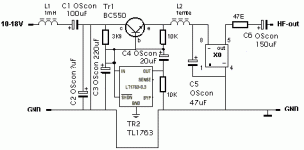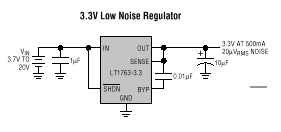I have been reducing the power supply noise to a Tent XO module feeding a PCM1704 DAC.
With a TL431/BC156 series pass ps as posted widely, the measured noise level was quite high, at around 60 uV wideband.
The sound improved over a resonant crystal arrangement, but not that dramatic.
Reducing noise gradually by using OSCONs at input, across the TL431 and at the output, I managed to get noise down to about 15 uV and here the sound improved significantly, with clearer highs and better bass, and a much more relaxed presentation.
Connecting a TL1763 LDO, however, I managed to get noise down to 8-10 uV, with reduced hf components but some 50 Hz evident in the trace. The sound has now become even better, with clear and smooth presentation. There was no need to use inductors at all.
Getting to this stage wasn't easy, and many insitu measurements were made relative to changes to the ps. However, it has proved worthwhile in that the sound is now much better. May be I should try a battery next? Throw away your 7805 and LT1086s, and try something better. The LT1763 has 20 uV specified noise, but a 150 uf OSCON at the output did the business.

With a TL431/BC156 series pass ps as posted widely, the measured noise level was quite high, at around 60 uV wideband.
The sound improved over a resonant crystal arrangement, but not that dramatic.
Reducing noise gradually by using OSCONs at input, across the TL431 and at the output, I managed to get noise down to about 15 uV and here the sound improved significantly, with clearer highs and better bass, and a much more relaxed presentation.
Connecting a TL1763 LDO, however, I managed to get noise down to 8-10 uV, with reduced hf components but some 50 Hz evident in the trace. The sound has now become even better, with clear and smooth presentation. There was no need to use inductors at all.
Getting to this stage wasn't easy, and many insitu measurements were made relative to changes to the ps. However, it has proved worthwhile in that the sound is now much better. May be I should try a battery next? Throw away your 7805 and LT1086s, and try something better. The LT1763 has 20 uV specified noise, but a 150 uf OSCON at the output did the business.

randytsuch said:Hi Fmak,
So, do you have a schematic of you final design?
Curious to see it.
-------------------------------------------
Just the LT1763 SMT 8 (not available in anything else) with 220uf feeding input and 150 uf 6.3V OSCON SG at the output. The chip sits on a DIL adaptor and a 6x3 cm ground plane, with fly lead connection to the pins. The whole thing was quite laborious to assemble. The larger LTs have higher noise but are easier to mount.
What type of XO do you have?
After reading your post I've been thinking about stacking some 9V batteries as a PSU for my XO3.
After reading your post I've been thinking about stacking some 9V batteries as a PSU for my XO3.
Tazzy said:What type of XO do you have?
After reading your post I've been thinking about stacking some 9V batteries as a PSU for my XO3.
Hi all,
I am happy to see that the hunt for low noise is paying off....
8-10uV equals 8 to 10 nV/Sqrrt Hz, when 1 MHz BW is still used (Fred ?).
Not bad for a commercially available LDO !
Using batteries, or a seperate transformer finally reduces the last trace of noise from a player, not to mention the last bits of potential ground loop problems
succes to you all
Guido
Cascaded reg's
The ground loop / 50(60) Hz stuff can be the hardest to get rid of, but with care it's not difficult.
Try cascaded reg's, connected as tracking pre-regualtors and always take the outputs from the o/p and ref terminals of the reg.
The latter bit is critical - if you take the o/p of most 3-terminal adjustables from anywhere other than the adj terminal sense point (i.e. where the R / C connect) you'll get signficant measurable and audible noise increase, which is a killer to a clock supply.
For digital (NOT analogue) supplies an AD8065 in a Jung reg gives VERY low noise that will be hard to maintain by other means.
This solution sounds better than a quieter AD797-based supply in my CDP, I suspect this is the better HF dynamic noise characteristics where the ear may be more sensitive to phase noise.
The noise on the PSU can be viewed as a modulation of the clock, the spectra is pretty important in my experience.
Andy.
The ground loop / 50(60) Hz stuff can be the hardest to get rid of, but with care it's not difficult.
Try cascaded reg's, connected as tracking pre-regualtors and always take the outputs from the o/p and ref terminals of the reg.
The latter bit is critical - if you take the o/p of most 3-terminal adjustables from anywhere other than the adj terminal sense point (i.e. where the R / C connect) you'll get signficant measurable and audible noise increase, which is a killer to a clock supply.
For digital (NOT analogue) supplies an AD8065 in a Jung reg gives VERY low noise that will be hard to maintain by other means.
This solution sounds better than a quieter AD797-based supply in my CDP, I suspect this is the better HF dynamic noise characteristics where the ear may be more sensitive to phase noise.
The noise on the PSU can be viewed as a modulation of the clock, the spectra is pretty important in my experience.
Andy.
Just for info - the plots below are the same reg, in the same CDP, measured in different places: -
Bad...

Better...

Unless you connect the circuit to the right place, all your hard work goes down the pan 😉
Bad...
Better...
Unless you connect the circuit to the right place, all your hard work goes down the pan 😉
ALW said:Just for info - the plots below are the same reg, in the same CDP, measured in different places: -
Bad...

Better...

Unless you connect the circuit to the right place, all your hard work goes down the pan 😉
Andy
What is de unit of measurement ?
regards
Re: Cascaded reg's
Hi
Cascading regulators (what I do) does not automatically solve the ground looop problems, as there is alwasy some transfer impedance spoiling the whole, allthough taking the output from the last reg or cap helps.
It does not help when the regulator generates noise, like the LM317T, as the noise is forced to run through the ground plane / wiring.
Do you hae measured noise figures of Jungs reg with AD8065 ?
I fully agree on your remark on the spectra here
best regards
ALW said:The ground loop / 50(60) Hz stuff can be the hardest to get rid of, but with care it's not difficult.
Try cascaded reg's, connected as tracking pre-regualtors and always take the outputs from the o/p and ref terminals of the reg.
The latter bit is critical - if you take the o/p of most 3-terminal adjustables from anywhere other than the adj terminal sense point (i.e. where the R / C connect) you'll get signficant measurable and audible noise increase, which is a killer to a clock supply.
For digital (NOT analogue) supplies an AD8065 in a Jung reg gives VERY low noise that will be hard to maintain by other means.
This solution sounds better than a quieter AD797-based supply in my CDP, I suspect this is the better HF dynamic noise characteristics where the ear may be more sensitive to phase noise.
The noise on the PSU can be viewed as a modulation of the clock, the spectra is pretty important in my experience.
Andy.
Hi
Cascading regulators (what I do) does not automatically solve the ground looop problems, as there is alwasy some transfer impedance spoiling the whole, allthough taking the output from the last reg or cap helps.
It does not help when the regulator generates noise, like the LM317T, as the noise is forced to run through the ground plane / wiring.
Do you hae measured noise figures of Jungs reg with AD8065 ?
I fully agree on your remark on the spectra here
best regards
Regarding the comment about a small amount of 50hz noise present, would it be wise to use a pre-regulator like the LM317 which if the adj is decoupled with a cap has reasonable noise reduction? Would this as well as a LT1763 "post regulator" offer the best solution?
ALW,
Can you explain this further, are you saying that you dont use the output terminal of a reg, you connect the load to the adj terminal?? Surely this will not be able to drive any load.
Also, regarding a JUNG regulator, will you get less noise than the 8-10uV quoted here for the LT solution?
Sorry for so many questions, just trying to learn the optimal solution for a low noise clock power supply.
Regards,
Dean
ALW,
The latter bit is critical - if you take the o/p of most 3-terminal adjustables from anywhere other than the adj terminal sense point (i.e. where the R / C connect) you'll get signficant measurable and audible noise increase, which is a killer to a clock supply.
Can you explain this further, are you saying that you dont use the output terminal of a reg, you connect the load to the adj terminal?? Surely this will not be able to drive any load.
Also, regarding a JUNG regulator, will you get less noise than the 8-10uV quoted here for the LT solution?
Sorry for so many questions, just trying to learn the optimal solution for a low noise clock power supply.
Regards,
Dean
Guido,
It's not calibrated in absolute terms, just dBv relative.
For the work I do, it's not been neccessary to know the absolute numbers, since I've not found a level at which it's inaudible, so better is better, in this case.
The supplies I normally use are some 20dB below those above (which IIRC are of an LT1086 + LM329 reference - I did them ages ago).
I strongly suspect the audibility of the higher frequency noise components is more critical, since the subjective improvement of the AD8065 (despite a high, in audio terms, noise corner) is large compared to the vanishingly low noise of an AD797-based supply across the audio band. The difference in noise being circa 6nV / rt Hz at 1k.
Unfortunately my HP analyser doesn't have a good enough phase noise spec to measure the actual clock - I need to build a comparative jig 🙁
Andy.
It's not calibrated in absolute terms, just dBv relative.
For the work I do, it's not been neccessary to know the absolute numbers, since I've not found a level at which it's inaudible, so better is better, in this case.
The supplies I normally use are some 20dB below those above (which IIRC are of an LT1086 + LM329 reference - I did them ages ago).
I strongly suspect the audibility of the higher frequency noise components is more critical, since the subjective improvement of the AD8065 (despite a high, in audio terms, noise corner) is large compared to the vanishingly low noise of an AD797-based supply across the audio band. The difference in noise being circa 6nV / rt Hz at 1k.
Unfortunately my HP analyser doesn't have a good enough phase noise spec to measure the actual clock - I need to build a comparative jig 🙁
Andy.
Can you explain this further, are you saying that you dont use the output terminal of a reg, you connect the load to the adj terminal?? Surely this will not be able to drive any load.
You have to connect the -ve (or +ve in a -ve output supply) of the circuit you're supplying to the adj. sense point - anywhere else and the supply is degraded - significantly. The o/p cap connection is important too - returning it to the Kelvin sense point directly may not be the best solution - same (but worse) for the input cap, which then decouples high noise levels into the ref point.
The +ve still comes from the reg. o/p, but the resistor from Vout must connect as close to the reg o/p as possible in the case of a standard 3-term reg, it should not share a current path with the main current flow- this degrades output performance - the data sheets tell you this, you just have to dig a bit deeper.
It does not help when the regulator generates noise, like the LM317T, as the noise is forced to run through the ground plane / wiring.
It does, if you connect as above, but you then have to consider the relative ground potential of other connected items, which can, I admit, be an issue.
That LT part above looks like a good choice - the ability to remote sense could be very useful!
Andy.
P.S. A lesson I learned the hard way - if you think it's not that critical, it almost always is, in audio 😉
ALW said:
It does, if you connect as above, but you then have to consider the relative ground potential of other connected items, which can, I admit, be an issue.
That LT part above looks like a good choice - the ability to remote sense could be very useful!
Andy.
P.S. A lesson I learned the hard way - if you think it's not that critical, it almost always is, in audio 😉
Andy
We agree here, but freedom of choosing the right ground point is sometimes limitted and therfor I choose to ommit noise generators like LM317T.
Yes, the hard way......
Following advise from my good friend Peter van Wilenswaard, i built a 60 dB preamp (using AD797) as front end of my HP3580A. That is how I measured 3 nV / Sqrrt Hz of my own supply.
all the best
Re: your mods to XO
If you use the LT1763-5 you don't need the series pass transistor I think. The LT1763-5 is rated for 500mA. This is more than sufficient for a clock supply. The datasheet shows a 1 µF electrolytic at the input and a 10 µF electrolytic cap at the output of the regulator. These can be Oscons.
Datasheet can be downloaded here:
http://www.linear.com/prod/datasheet.html?datasheet=520
😎
Hi pedro,pedro said:Fred,
Are your mods something like this?
If you use the LT1763-5 you don't need the series pass transistor I think. The LT1763-5 is rated for 500mA. This is more than sufficient for a clock supply. The datasheet shows a 1 µF electrolytic at the input and a 10 µF electrolytic cap at the output of the regulator. These can be Oscons.
Datasheet can be downloaded here:
http://www.linear.com/prod/datasheet.html?datasheet=520
😎
Jean Paul,
It's not joking, it's just misunderstangind and ignorance, I'm afraid.
In fact, I'm trying to understand Fred's mods, and I posted some e-mails to him but, till now, this mods remain a mistery to me.
Elso,
I've e-mailed to you some minutes ago.
I'm going to take a look to the pdf you point. But I suppose I'll not understand much :-(
Thanks both of you for your comments!
It's not joking, it's just misunderstangind and ignorance, I'm afraid.
In fact, I'm trying to understand Fred's mods, and I posted some e-mails to him but, till now, this mods remain a mistery to me.
Elso,
I've e-mailed to you some minutes ago.
I'm going to take a look to the pdf you point. But I suppose I'll not understand much :-(
Thanks both of you for your comments!
Pedro, just look at the typical application in the datasheet. Now change the caps at the input and output with OSCON in the values Fred gave. That's all if I understood it well. BTW the attached drawing is for the 3.3 V version of the regulator, couldn't find another one.
The 1 uF can be a 220 uF 10 V OSCON and the 10 uF at the output can be 150 uF 6.3 V OSCON.
The 1 uF can be a 220 uF 10 V OSCON and the 10 uF at the output can be 150 uF 6.3 V OSCON.
Just the LT1763 SMT 8 (not available in anything else) with 220uf feeding input and 150 uf 6.3 V OSCON SG at the output. The chip sits on a DIL adaptor and a 6x3 cm ground plane, with fly lead connection to the pins. The whole thing was quite laborious to assemble. The larger LTs have higher noise but are easier to mount.
Attachments
- Status
- Not open for further replies.
- Home
- Source & Line
- Digital Source
- More on Clock Power Supply

